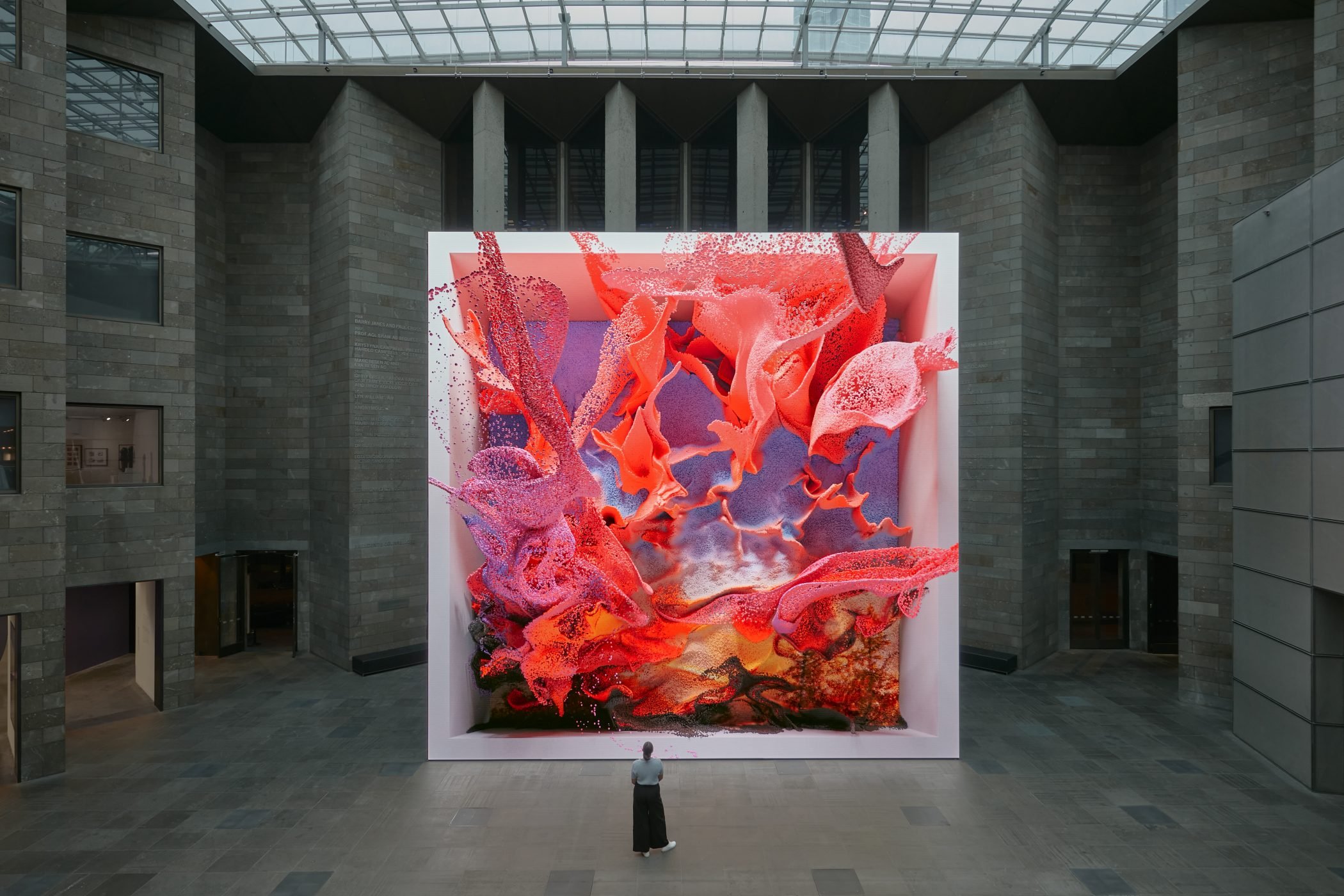
At a time of increasing anxiety around the role of artificial intelligence in contemporary society, one artist continues to lean unapologetically into the power of machines. That’s Refik Anadol, the Turkey-born Los Angeles-based new media creative (though he considers himself a painter), who, for much of the past decade, has used data as paint and algorithms as artistic tools. The results may not assuage our technological worries, but most often they’re colossal, mesmeric, and thought-provoking.
Anadol’s just-opened first solo show in his adopted city, “Living Paintings” at Jeffrey Deitch, presents new iterations of his long-time fascinations, albeit with a California focus. These include works visualizing the environmental data of Los Angeles, a data wall of the Pacific Ocean, working with a dataset of images from California’s national parks, and a revamped Infinity Room.
In short, “Living Paintings” both nods at Anadol’s past work and winks at the future. Here, we revisit five of the most important works from Anadol’s machine-propelled career so far.
1. Infinity Room,
Istanbul Biennial
(2015)
Courtesy Refik Anadol Studio.
Today, art-centered immersive experiences featuring projection mapping and tailored sound designs may be commonplace, but they weren’t in 2015 when Anadol unveiled Infinity Room in collaboration with the Istanbul Biennial. The artist created a mirrored room into which he projected largely black-and-white abstract landscapes, ones that contorted and changed ceaselessly. The goal, as the artist put it at the time, was to heighten the visitor’s physical awareness through immersion in a non-physical world. Some “immersants” described experiencing zero gravity. Infinity Room has since been experienced by more than two million people at venues across the U.S. including San Francisco’s Exploratorium, the Scottsdale Museum of Contemporary Art, and Washington D.C.’s Artechouse.
2. Walt Disney Concert Hall Dreams,
The Los Angeles Philharmonic (2018)
Courtesy Refik Anadol Studio.
How do you visualize the sounds of an orchestra? This was the question Anadol was tasked with answering for the Los Angeles Philharmonic’s centennial celebrations. With a little help from a team at Google Arts and Culture, he created a data universe out of 40,000 hours of recordings in which millions of data points were categorized into hundreds of attributes. Anadol then leveraged machine intelligence to explore the connections of these categories—or “memories” as the artist labels them. These explorations were visualized in the form of stunning data sculptures that were cast on the Frank Gehry-designed Walt Disney Concert Hall using 42 large-scale 50K projectors. Naturally, the week-long public spectacle was accompanied by archival recordings from the Philharmonic’s database, ones that were selected and woven together using machine-learning algorithms.
3. Seoul Haemong,
Dongdaemun Design Plaza in Seoul, South Korea
(2019–20)
Courtesy Refik Anadol Studio.
Every night for nine months, the DPP, a cultural center in Seoul’s bustling entertainment district, was aglow with stories of the city. In collaboration with the City of Seoul, Anadol’s studio collected millions of citizen’s narratives in the form of photographs as well as archival pictures of the Dongdaemun area. Anadol then tasked machine learning with finding connections between these stories with the results projected onto the Zaha Hadid Architects-designed building. Anadol sought to capture the essence of a place, an idea he had previously explored through his Winds of Boston and Winds of Dubai works, efforts that are more focused on interpreting environmental data. Seoul Haemong launched the now annual Seoul Light festival, and was appreciated for being a public artwork created by the people and for the people.
4. Machine Hallucinations,
Hong Kong
(2021)
“Machine Hallucinations Space: Metaverse” by Refik Anadol at the Digital Art Fair Asia. Photo: Anthony Kwan/Getty Images.
Anadol is an artist for whom a dataset is a palette and a machine both brush and chisel. Given all of his major works celebrate the potential creativity of computing power, a venture into the world of NFTs was inevitable. In late 2021, as part of the Digital Art Fair Asia, he partnered with Sotheby’s Hong Kong to mint the latest iteration of his ongoing Machine Hallucinations series. The auction featured eight NFTs centered on more than two million images of space captured by International Space Station, and the Hubble and MRO telescopes. His poetic aim was to try and capture what the telescopes’ dreams of the universe might look like. The collection sold for $5 million.
5. Unsupervised,
Museum of Modern Art
(2022)
Courtesy of MoMA.
Receiving a commission by America’s foremost modern art museum remains a major milestone for any artist—and doing so before the age of 40 cemented Anadol’s status as the leading purveyor of generative A.I. art. Unsupervised, part of his Machine Hallucinations series, feeds all 138,000 artworks from the museum’s collection through meticulously curated algorithms that duly cast shapeshifting images onto a towering 24-foot-tall screen in the lobby. The piece is created in real time, meaning images never recur, and though derided by some critics as a costly and shallow screensaver, Unsupervised remains beguiling, fun, and most certainly Instagrammable. “I first came to MoMA in 2011,” the artist told Artnet News at the work’s unveiling. “To have work here and be one of the first things visitors see is amazing.”
“Refik Anadol: Living Paintings” is on view at Jeffrey Deitch, 925 N. Orange Drive, Los Angeles, through April 29, 2023.